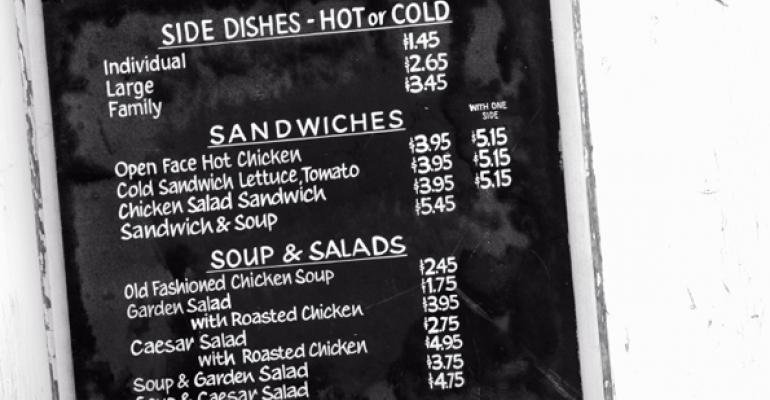Restaurant chains are increasingly reluctant to raise menu prices despite projections of a 3-percent increase in commodity prices overall in 2013, according to a new survey by purchasing support firm SpenDifference LLC.
Menu prices rose in 2012 at a slightly lower average rate than in 2011, according to the 35 chain restaurant executives across all segments that responded to the Denver-based firm’s surveys.
The survey that was conducted in November recorded annualized menu price hikes averaging about 1.2 percent midway through the fourth quarter — though some respondents said more price increases were planned before the end of the year. By comparison, the same executives responding to the survey in 2011 said they raised prices by about 1.5 percent, said Brad Moore, SpenDifference’s senior vice president of client services.
In 2012, 20 percent of the survey respondents said they took no price increases at all. That was more than in 2011, when 11.4 percent of the same group said they did not raise prices. And of those that did hike prices, the majority — or 63 percent — reported taking across-the-board increases, while 23 percent said they limited higher pricing to certain menu items.
RELATED
• No commodity cost relief in sight for restaurants
• Menu price increases modest despite rising commodities costs
• More restaurant industry commodities news
That is troubling, said Moore, because it indicates that many chains feel they have passed the stage where they can address shrinking margins in other ways. “It means they’re past the menu engineering stage,” said Moore. “Essentially, they’re taking increases more broadly.”
The survey respondents estimated their food costs overall for 2012 increased about 1.7 percent. Commodity costs increased 2 percent last year, the report said, with costs for some items like beef and dairy rising more than 5 percent.
“[Restaurant chains] were taking modest increases, recognizing they weren’t as great as inflation, but their bigger concern was traffic,” said Moore.
Though nearly one-third of respondents said their same-store sales increased 4 percent or more during the third quarter last year, those chains also revealed that traffic trends lagged, which could speak to the lack of consumer confidence in the economy and the potential impact of multi-year menu price hikes, the report found.
For 2013, the picture is expected to be worse, with commodity prices projected to rise 3 percent overall, with some protein costs rising as much as 15 percent, the survey said.
“You can’t take that in pricing,” said Moore. That puts many chains in a quandary, as consumers continue to focus on value, he added.
Though the first half of the year will likely see restaurants caught between high commodity pricing and low consumer confidence in the economy, the commodity picture is expected to return to more normal levels in the second half — assuming there is no drought this summer, according to Moore. That means restaurant chains are going to need to be proactive about their purchasing and supply chain management, he noted.
Though 71 percent of respondents said they raised prices in some form last year, they also cited other means to counter rising commodity prices, the report found. Almost 26 percent of respondents said they reduced portion sizes, for example. Nearly 63 percent said they renegotiated purchasing contracts, 66 percent said they promoted items with lower food costs, and almost 29 percent said they eliminated high-food-cost items altogether. Another 37 percent of respondents said they changed suppliers and 34 percent increased their use of third-party purchasing organizations.
The key, said Moore, is getting through the next few months.
“Later in the year, we’ll be getting pricing back to a more normal environment, but the quandary now is how to take pricing given that expectation,” he said.
Contact Lisa Jennings at [email protected].
Follow her on Twitter: @livetodineout





